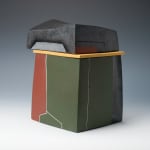Hayashi Yasuo 林康夫 Japanese, b. 1928
23.9 × 17.3 × 16.5 cm
Further images
-
(View a larger image of thumbnail 1
)

-
(View a larger image of thumbnail 2
)

-
(View a larger image of thumbnail 3
)

-
(View a larger image of thumbnail 4
)

-
(View a larger image of thumbnail 5
)

-
(View a larger image of thumbnail 6
)

-
(View a larger image of thumbnail 7
)

-
(View a larger image of thumbnail 8
)

-
(View a larger image of thumbnail 9
)

-
(View a larger image of thumbnail 10
)

-
(View a larger image of thumbnail 11
)

-
(View a larger image of thumbnail 12
)

-
(View a larger image of thumbnail 13
)

-
(View a larger image of thumbnail 14
)

Hayashi Yasuo began his artistic career in the 1950s, and is now considered one of the most important forerunners of abstraction in contemporary Japanese ceramics. As a founding member of the Shikokai association of potters, he played a role in the modernization of the medium from the very beginning. The Shikokai group boldly explored new forms for ceramics, and took the medium in truly innovative sculptural directions. Not only was Hayashi the group’s youngest member, but also its most celebrated. His abstract ceramic sculpture far outshined that of his contemporaries. His playful take on formalism recalls the ideas behind the Minimalist movement in America in its willingness to experiment with the boundaries between two- and three-dimensionality, exemplified in this piece
At the exceedingly young age of 16 years old, Hayashi Yasuo (b. 1928) was enlisted to the Japanese military as a part of the Japanese Special Attack Unit of military aviators, a Kamikaze pilot. Though it never came to be that he flew a military mission, his training regimes were intense and full of trauma. This piece is a reflective piece that meditates upon his experiences flying over the Kyoto sky. He saw the rooftops of Kyoto’s thatched and ceramic brick roofing, and interpreted those forms through the visual vocabularies of geometric abstraction. In this piece, as well as his “Memory of the House” series, he plays upon distance, depth, and motion in his layering of linear forms on a 2 dimensional surface, interplaying with the notion that 3 dimensions can be represented on 2 dimensional surfaces in this compact piece. This interplay in perception is a common motif found in his oeuvre.
Another recent work of Hayashi’s this piece melds Geometric Abstraction with concepts stemming from assemblage art. The top of the piece along with the yellow fat segment are detachable: the viewer of the piece is able to construct and deconstruct the piece. This aspect of the work also speaks to the tension between functional vessels and non-functional objects in the history of Japanese ceramics and the ceramic industry.
This tension dominated debates about the ceramic object in the 1950s, with the rise of both the Sodeisha movement and the Shikokai movement, both of which Hayashi belonged to.In this piece, He was inspired by notions of home and hearth, and the “building blocks” that constitute his homestead. From the perspective of almost 8 decades of artistic practice, assemblage art has become an innovative way for Hayashi to bring his artistic practice to new heights. As the forerunner of contemporary Post-war and avant-garde sculptural ceramics in Kyoto, this piece is a graceful articulation of his Home and house series.
- X
- Tumblr


















